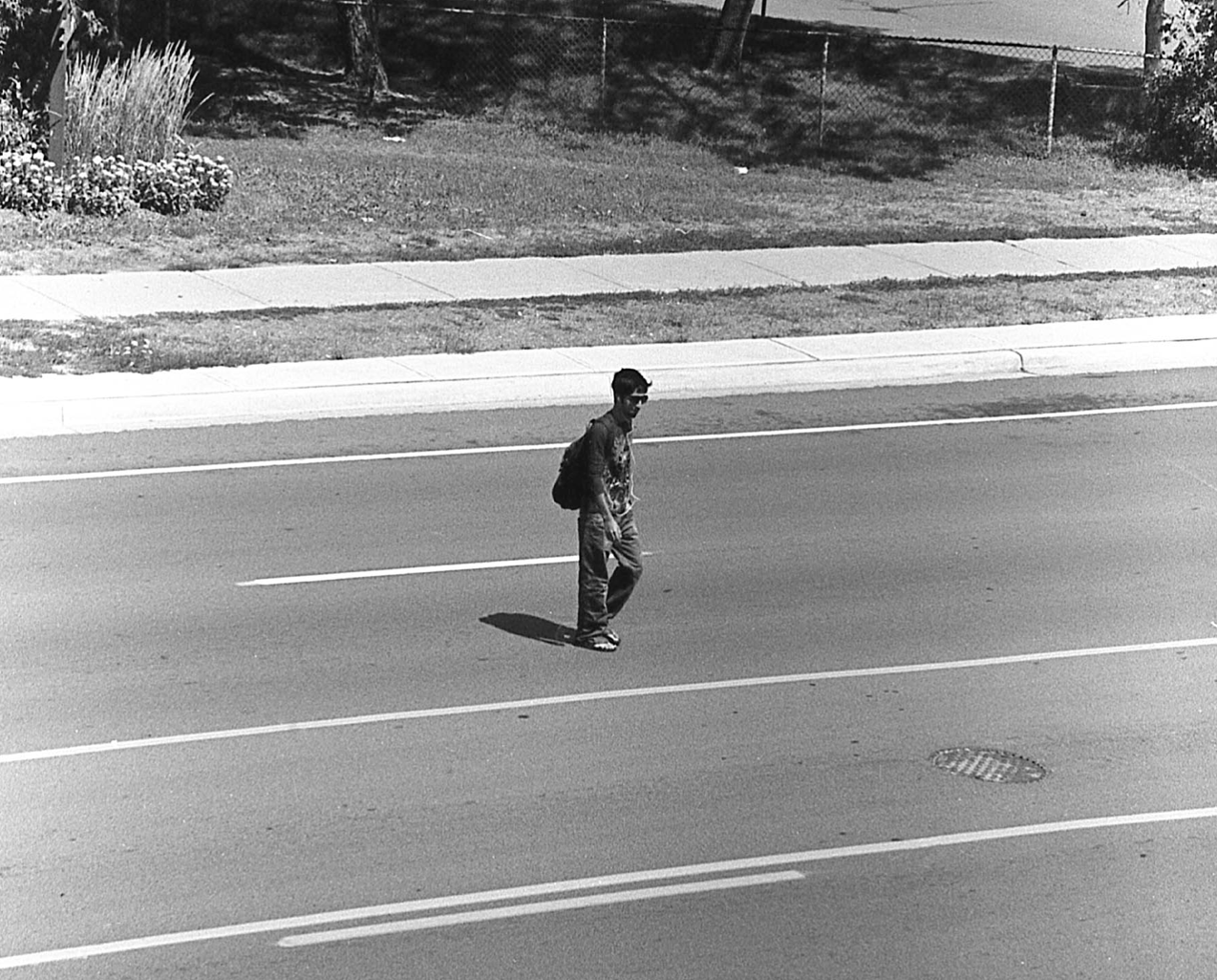These Communities Are Making Progress After ‘Jaywalking’ Reform
12:01 AM EDT on June 23, 2022

Photo: Missi, CC
The Black Lives Matter protests and the pandemic have dramatically shifted the terrain around policing. As a result, the last two years have brought about the first serious rethinking of jaywalking laws in a century, challenging a practically universal American rule that dates back to some of the earliest auto industry lobbying campaigns.
The state of Virginia kicked things off by decriminalizing jaywalking in March 2021, followed by Kansas City, Mo. one month later. The state of Nevada did the same in June. About 12 million Americans now live in places where jaywalking has been decriminalized in some form.
The movement suffered a serious blow last October, however, when California Governor Gavin Newsom vetoed legislation passed by the state’s legislature that would have decriminalized jaywalking for the state’s 39 million residents. Newsom used alleged safety concerns as the basis for his veto.
But a modified bill is moving its way through the California legislature right now. Safety groups like California Walks and Los Angeles Walks as well as national groups like America Walks were key advocates for the reform in California, recognizing that street safety concerns for Black and Latino pedestrians also include concerns about police profiling and brutality, which are frequently associated with jaywalking enforcement.
In addition, the movement to reframe the way we regulate walking has opened the door for a more fundamental rethinking of the way we frame pedestrian safety. These efforts represented a shift from a “pedestrian responsibilities” framework to a “pedestrian rights” framework.
One unintended consequence of our “jaywalking” laws is how they create the implicit assumption that if a pedestrian is struck by a car, they somehow "deserved" it — even when sidewalk and crosswalk infrastructure are woefully incomplete or dangerously lacking.
Now it has been more than a year since the first of these reforms went into place, and we can get an early sense of how it is working out.
This data is noisy — especially in smaller communities like cities, which may have relatively few p edestrian deaths in an average year. And it must be noted that these reforms happened in the context of a wider transportation system that's experiencing rising pedestrian deaths nationally.
However, one thing the early data seems to show is that jaywalking laws themselves are not producing the kind of safety disaster some opponents predicted. In fact, according to the data we could find in each jurisdiction, there didn’t appear to be any noticeable impact at all.
Virginia — March
Here’s a look at what’s been happening with pedestrian deaths and serious injuries in Virginia, which was the first to decriminalize jaywalking in March 2020. Jaywalking was eliminated as a primary offense through an action of the Legislature, as part of a package of criminal justice reforms targeting common sources of “pretextual” police stops like tinted windows and the smell of marijuana.

This specific measure flew under the radar and was barely reported, says Wyatt Gordon, a reporter at the Virginia Mercury who covered the development. But the measure was included in the legislation at the request of biking and walking advocacy groups as well as criminal justice reformers who pointed out that the law was frequently used to target homeless people.
Gordon says he’s not surprised it doesn’t seem to have had much effect on safety numbers and he thinks it's probable that the majority of Virginians aren’t aware of the change.
"At the end of the day jaywalking is more of a criminal justice issue than a pedestrian safety issue,” said Gordon, adding he doesn’t think fines are an effective deterrent. “The consequence of getting killed is far worse than the consequence of a misdemeanor ticket.”
As you can see in the above graph, which shows data from Virginia’s DMV, the commonwealth had a pretty typical year in 2021 in terms of pedestrian deaths and injuries. The trendline since 2016 actually shows a gradual decrease in fatalities, which is at odds with national trends, where these kinds of deaths have been accelerating rapidly. It should be noted as well that 2021 was an especially bad year, nationally.
Kansas City (MO) — May
Kansas City went farther than other jurisdictions and completely eliminated jaywalking from its criminal code in May 2021. The statute was removed as part of a wider initiative initiated by Mayor Quinton Lucas as part of a wider reform aimed at addressing racially biased pretextual police stops.
Michael Kelley is policy director at Bike Walk Kansas City, which pushed for the inclusion of bike and pedestrian infractions on the list of ordinances that were struck from the city’s books.
“Jaywalking is something that is specifically about punishing people who are navigating the environment that wasn’t made for them,” said Kelley.
The latest data about pedestrian deaths is not available yet from Kansas City, but we’ll be keeping a close eye on it.
Nevada — June
Last June, the Fines and Fees Justice Center successfully lobbied for jaywalking reform in Nevada, along with a raft of other changes aimed at eliminating the kinds of infractions that likely lent themselves to racial profiling.
Leisa Moseley, Nevada State Director for the group, says a lot of law enforcement officials are upset about the change.
“They’re saying this legislation prevents them from stopping people from jaywalking,” she said. “It does not. What it prevents them from doing is stopping people and arresting people for jaywalking.”
Under Nevada’s new law, jaywalking was changed from a misdemeanor to a civil fine ($100). As a result, Moseley said, police seem to have lost interest in enforcing the rule, which was frequently used as a pretext to stop-and-frisk people in low-income or Black or Latino neighborhoods.
But some law enforcement groups' contention that pedestrian safety has worsened as a result doesn’t seem to be borne out by a close look at the data. There were 85 pedestrian deaths in 2021, up from 82 the year prior. But that seems to be noise, not any effect of the law changing. Overall traffic deaths were up 18 percent statewide that year while pedestrian deaths rose 3.6 percent.
The bigger safety problem is Nevada’s unsafe streets, Moseley said.
“They’re not designed for pedestrian safety, they're designed for cars,” she said. “Even our laws are designed for cars.”
California — Soon?
America Walks was immensely disappointed when Gavin Newsom vetoed a bill that would have decriminalized walking in California last fall. However, the good news is, a modified version of that bill is currently making its way through the legislature in the Golden State.
A bill sponsored by Assembly Member Phil Ting (D-San Francisco) — AB2147, the Freedom to Walk Act — was passed in the Assembly. It has been assigned to the Public Safety Committee in the Senate.
“Jaywalking laws go largely unenforced in affluent communities throughout the state, where people walk freely without consequence,” said Rio Scharf, an attorney with Lawyers' Committee for Civil Rights of the San Francisco Bay Area, a sponsor of the bill. “But in the communities we serve, these citations are a cause of discriminatory police stops and significant court debt.”
If California moves forward with its change, about 51.4 million Americans will live in a jurisdiction that has decriminalized walking. That’s a big change over a short time and one that, at this point, doesn’t seem to be having much effect on safety, while helping protect the civil rights of people of color and preserving police resources for real safety issues.
Conclusion
It is our goal to decriminalize jaywalking in all US states and territories. If you are working on such an effort, or know of such an effort, let us know.
Editor's note: A version of this article originally appeared on the America Walks blog and is republished with permission.
Angie Schmitt is one of the country's best known writers and experts on the topic of sustainable transportation. She was the long-time national editor at Streetsblog. Her writing and commentary have appeared in the New York Times, The Atlantic, and National Public Radio. She is the author of Right of Way: Race, Class, and the Silent Epidemic of Pedestrian Deaths in America.
Angie Schmitt is the author of Right of Way: Race, Class and the Silent Epidemic of Pedestrian Deaths in America, and the former editor of Streetsblog USA.
Read More:
Stay in touch
Sign up for our free newsletter
More from Streetsblog USA
Kiss Wednesday’s Headlines on the Bus
Bus-only lanes result in faster service that saves transit agencies money and helps riders get to work faster.
Four Things to Know About the Historic Automatic Emergency Braking Rule
The new automatic emergency braking rule is an important step forward for road safety — but don't expect it to save many lives on its own.
Who’s to Blame for Tuesday’s Headlines?
Are the people in this photo inherently "vulnerable", or is this car just dangerous?
Why Riders With Disabilities Have To Sue For Accessible Transit Stops
A Bay Area transit agency is only the latest to be sued over inaccessible stations. What will it take to get every American stop ADA compliant?
Monday’s Headlines Reconnect With Pete
More than $3 billion is flowing out of the White House to help correct infrastructure mistakes in Black communities.





